33 1/3 Revolutions Per Monkee: The Monkees on Record, Part 1
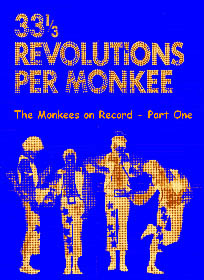 From the very beginning, the concept of The Monkees was intended to be one thing and that was a television show. Like many shows of the day, tie in merchandise was a profitable sideline and soundtracks sold well. It was not uncommon to see performers who were not musicians or even singers (Jack Webb and William Shatner to name but two) put out albums. The Monkees progression from television characters to a genuine viable musical group was an impressive one but I will let their albums speak for themselves.
From the very beginning, the concept of The Monkees was intended to be one thing and that was a television show. Like many shows of the day, tie in merchandise was a profitable sideline and soundtracks sold well. It was not uncommon to see performers who were not musicians or even singers (Jack Webb and William Shatner to name but two) put out albums. The Monkees progression from television characters to a genuine viable musical group was an impressive one but I will let their albums speak for themselves.
THE MONKEES Colgems COM/COS 101 October 1966. Released almost one month to the day after the national premier of the television series, The Monkees (often referred to as Meet the Monkees due to the back cover proclamation) was a soundtrack to the show that was 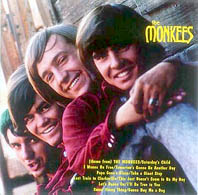 already exceeding its purpose. The majority of the songs on the album were written by the talented duo of Tommy Boyce and Bobby Hart who would follow the Monkees throughout their career. The track selection ranges from simple ballads like I Wanna Be Free to novelties like Gonna Buy Me a Dog to sure-fire hits like The Last Train to Clarkesville. Buried in this mixture of prefabricated pop are two Michael Nesmith tunes that stand out like sore thumbs –- one on each side. Papa Gene’s Blues(misprinted as Jean’s on the first pressings of the albums) and Sweet Young Thing (written in conjunction with Carol King and Gerry Goffin) are early examples of the catchy country-fied rock tunes The Nez would become known for. All of the songs received heavy exposure on the series and this album still stands as the finest example of what this business venture was originally intended to be.
already exceeding its purpose. The majority of the songs on the album were written by the talented duo of Tommy Boyce and Bobby Hart who would follow the Monkees throughout their career. The track selection ranges from simple ballads like I Wanna Be Free to novelties like Gonna Buy Me a Dog to sure-fire hits like The Last Train to Clarkesville. Buried in this mixture of prefabricated pop are two Michael Nesmith tunes that stand out like sore thumbs –- one on each side. Papa Gene’s Blues(misprinted as Jean’s on the first pressings of the albums) and Sweet Young Thing (written in conjunction with Carol King and Gerry Goffin) are early examples of the catchy country-fied rock tunes The Nez would become known for. All of the songs received heavy exposure on the series and this album still stands as the finest example of what this business venture was originally intended to be.
Trivia – The Monkees first few months as a group were very hectic ones as they were constantly jockeyed between film sets, recording studios, and personal appearances. The cover photo for this LP was taken during a short break in recording, near the end of the day when everyone was more than ready to go home. Mike Nesmith became increasingly irritated with the amount of time the photographer was taking to get the shot and finally informed him he had until the count of ten to get his picture or he was walking. Nesmith was on six in his countdown when the photograph that would grace the front of their first hit album was snapped.
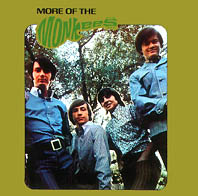 MORE OF THE MONKEES Colgems COM/COS 102 January 1967. Just three short months after their smash debut, Colgems wasted no time in releasing a follow up album for their new smash sensations. Like most sequels, More does not live up to the standards set by its predecessor but it is still a strong album. Solid tracks like She and Nesmith’s Mary, Mary had to be passed over as singles to make room for the double A sides of I’m A Believer (written by Neil Diamond) and Boyce and Hart’s (I’m Not Your) Steppin’ Stone. There were a few misfires like Laugh and The Day We Fall in Love (both featuring Davy’s saccharin vocals) that proved the Monkee machine was either not finely tuned yet or was being driven inconsistently. Peter Tork also had one of his two moments to shine on this album with the comical Your Auntie Grizelda. With the momentum of the series in high gear, More entered the charts at number one and went on to become the best selling Monkees’ album of all time.
MORE OF THE MONKEES Colgems COM/COS 102 January 1967. Just three short months after their smash debut, Colgems wasted no time in releasing a follow up album for their new smash sensations. Like most sequels, More does not live up to the standards set by its predecessor but it is still a strong album. Solid tracks like She and Nesmith’s Mary, Mary had to be passed over as singles to make room for the double A sides of I’m A Believer (written by Neil Diamond) and Boyce and Hart’s (I’m Not Your) Steppin’ Stone. There were a few misfires like Laugh and The Day We Fall in Love (both featuring Davy’s saccharin vocals) that proved the Monkee machine was either not finely tuned yet or was being driven inconsistently. Peter Tork also had one of his two moments to shine on this album with the comical Your Auntie Grizelda. With the momentum of the series in high gear, More entered the charts at number one and went on to become the best selling Monkees’ album of all time.
Trivia – If the photo on the cover of More of the Monkees looks a little unusual, that’s because it wasn’t intended for the front of a record album. Columbia was doing all the cross merchandising they could sign up at this time and one of those cash-ins was a line of clothing for retailer J.C. Penney. The Monkees were photographed for an ad campaign for the clothes line that had to serve double duty when More was rushed into release so quickly there wasn’t time for a proper photo shoot. The back cover of the album consists of a group of publicity shots from the series with the liner notes written by the soon to be dismissed Don Kirshner.
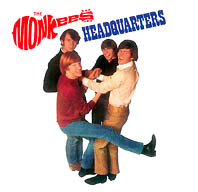 THE MONKEES HEADQUARTERS Colgems COM/COS 103 May 1967. The march of Monkee madness continued with their third album in less than a year! Following the release of More, Producer and President of Colgems Records, Don Kirshner, overstepped his boundaries with both Columbia and the Monkees and was removed from the entire project a few months later. The post-Kirshner Monkees took every advantage of their new found musical freedom and actually recorded an album like a real band! The results are clearly not as commercial as the first two LPs but the absence of studio polish gives the group a more distinctive sound. The tracks are a mixed bag with the four members developing their individual styles while still managing to work as a cohesive unit. Nesmith comes through with three strong contributions, the catchy You Told Me and Sunny Girlfriend (a popular number in their concerts) plus one of his most fondly remembered Monkee tracks, You Just May Be the One. Davy continued with his signature ballads but actually scored gold with the under appreciated Shades of Gray. Peter and Mickey finally got an opportunity to contribute as writers with the impressive For Pete’s Sake (which would become the closing theme for the second season) and Randy Scouse Git, a bluesy rocker named for English slang (which roughly translates into “horny Liverpool bastard” and was referred to as Alternate Title on European pressings of the album). The Monkees were loose in the studio and proving they were more than the manufactured image critics had labeled them.
THE MONKEES HEADQUARTERS Colgems COM/COS 103 May 1967. The march of Monkee madness continued with their third album in less than a year! Following the release of More, Producer and President of Colgems Records, Don Kirshner, overstepped his boundaries with both Columbia and the Monkees and was removed from the entire project a few months later. The post-Kirshner Monkees took every advantage of their new found musical freedom and actually recorded an album like a real band! The results are clearly not as commercial as the first two LPs but the absence of studio polish gives the group a more distinctive sound. The tracks are a mixed bag with the four members developing their individual styles while still managing to work as a cohesive unit. Nesmith comes through with three strong contributions, the catchy You Told Me and Sunny Girlfriend (a popular number in their concerts) plus one of his most fondly remembered Monkee tracks, You Just May Be the One. Davy continued with his signature ballads but actually scored gold with the under appreciated Shades of Gray. Peter and Mickey finally got an opportunity to contribute as writers with the impressive For Pete’s Sake (which would become the closing theme for the second season) and Randy Scouse Git, a bluesy rocker named for English slang (which roughly translates into “horny Liverpool bastard” and was referred to as Alternate Title on European pressings of the album). The Monkees were loose in the studio and proving they were more than the manufactured image critics had labeled them.
Trivia – There are actually two variations of the Headquarters album based on the back cover photos. The lower center photo of the original pressings features a photo of studio engineer Dick Bogert and Producer Douglas Hatfield. Bogert was misidentified as fellow engineer Hank Cicalo in the pictures caption and three million copies of the album were distributed before anyone caught the mistake! When the album was later repressed, the photo was replaced with one that actually did feature Cicalo along with some scruffy looking Monkees. Since everyone except Davy is sporting facial hair in the shot, this rarer version of the album became referred to as the “beards cover” by collectors.
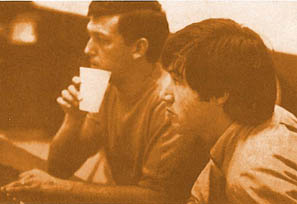
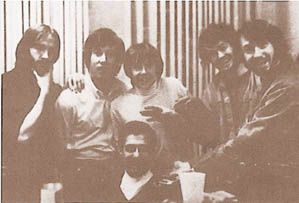
Coming in Part 2: Zodiacs, Birds, Bees, and one very large Head!
